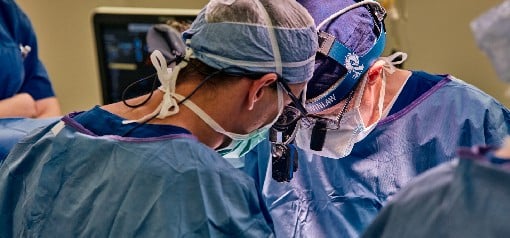
Spinal Anesthesia: A Gentle Approach for Our Little Ones
When a baby or toddler needs surgery, it's natural to worry about their comfort and safety. Spinal anesthesia offers a gentle and effective option for some patients and is available from Lurie Children’s pediatric anesthesiology specialists.
What is Spinal Anesthesia?
While general anesthesia induces medical unconsciousness in the entire body, spinal anesthesia selectively numbs a particular region. For young children, this means they can sleep on their own, without the help of a breathing device, during their procedure while being comfortable and pain-free.
Infants and toddlers who need an operation below the belly button, such as hernia repair, circumcision or clubfoot surgery, may be candidates for spinal anesthesia.
“Spinal anesthesia can be a great choice for young children having a procedure,” said Dr. Olutoyin Olutoye, Lurie Children’s Anesthesiologist-in-Chief. “It’s safe, quick and helps children recover faster, and feel better afterward. Our team at Lurie Children’s is uniquely equipped to offer this alternative to general anesthesia.”
Why Choose Spinal Anesthesia?
- Fewer Risks: Spinal anesthesia avoids the potential risks associated with general anesthesia, such as difficulty waking up, agitation or nausea. Most children receiving spinal anesthesia will also not need to have a breathing device placed to help with breathing.
- Quicker Recovery: The child will wake up quicker and will be able to return to normal activities sooner.
- Less Stress: Spinal anesthesia can help reduce stress and anxiety for caregivers and helps ensure a gentler experience for the child during anesthesia and surgery.
The Procedure
Before the procedure, the child will receive a mild sedative to help them relax. In addition, the child will receive some numbing cream on the back. In the operating room, a very thin needle is then gently inserted into the lower back (in the area where the numbing cream was applied) to deliver the anesthetic medication. Once the medication takes effect, your child will be numb from the waist down.
In most cases, the child falls asleep soon after entering the operating room and remains asleep during the procedure. If the child wakes up, which is rare, the pediatric anesthesiology team will help them go back to sleep using a pacifier, warm blankets or soothing music.
Our Expertise
Lurie Children’s specializes in care for kids, and we have a team of experienced anesthesiologists who specialize in this technique. We're committed to providing the safest and most comfortable care for your child. All Lurie Children’s anesthesiologists are board-certified in both pediatric anesthesia and general anesthesia.
Furthermore, Lurie Children’s has earned a Level 1 verification by the American College of Surgeons (ACS) Children’s Surgery Verification Quality Improvement Program (CSV), recognizing the hospital’s commitment to meeting the highest standards of quality surgical care.
A Smoother Journey
If your child who is 18 months old or younger is scheduled for a procedure below the belly button, talk to your doctor about spinal anesthesia. It may be the right choice for a gentler surgical experience.
Sign up for our Newsletter
Get health tips from our pediatric experts, news about ground-breaking research, and feel-good moments delivered right to your inbox.
Additional Blog Posts

Why Lurie Children's is the Right Choice for Your Child's Heart Transplant
Choosing the right hospital for a child’s heart transplant is one of the most significant decisions a family can make. Our Heart Center team wants to help make this decision easier.
Read More

Pediatric Fractures: A Parental Guide
When a child breaks a bone, it may raise many concerns and questions for caregivers. Learn more in our guide on pediatric fractures for parents.
Read More

Concussion in Toddlers & Babies: Symptoms & Treatment
Toddlers and babies often hit their heads, so it's important to understand the signs of concussion, prevention and treatment.
Read More